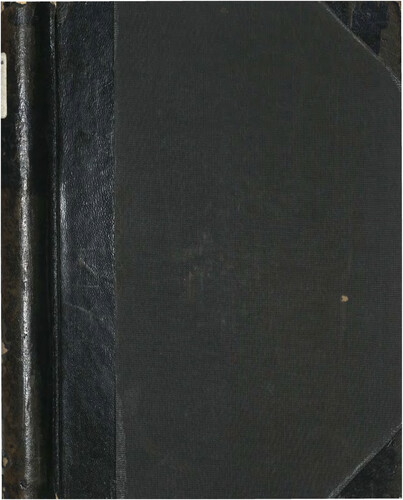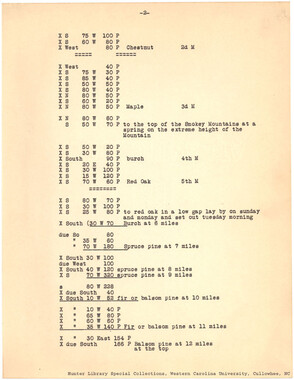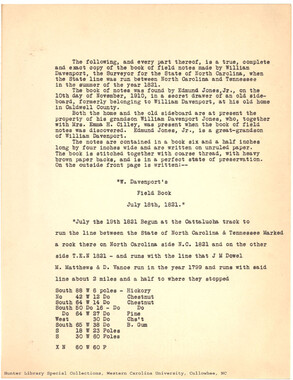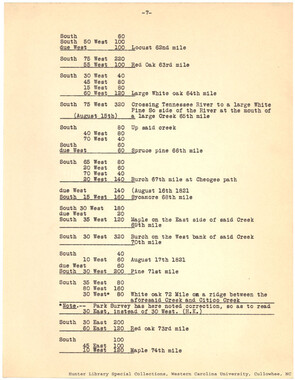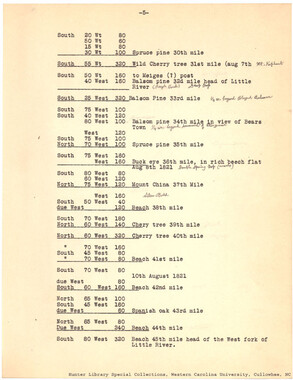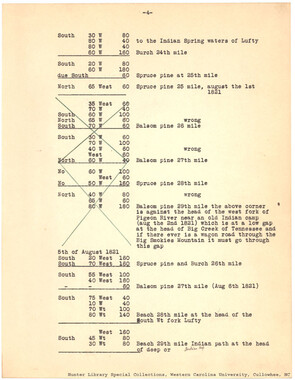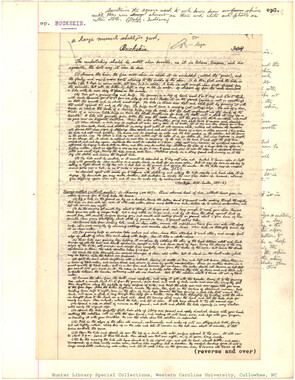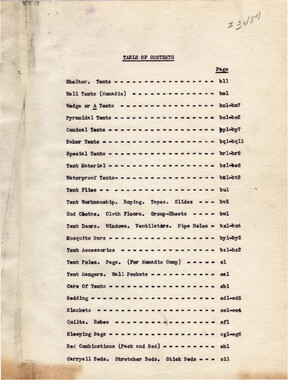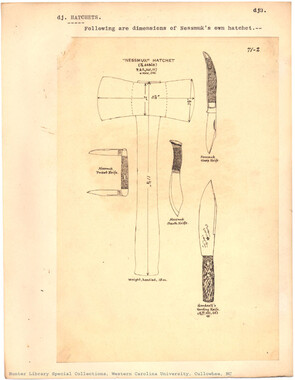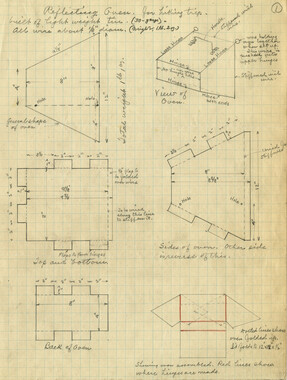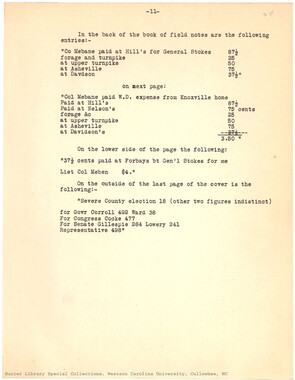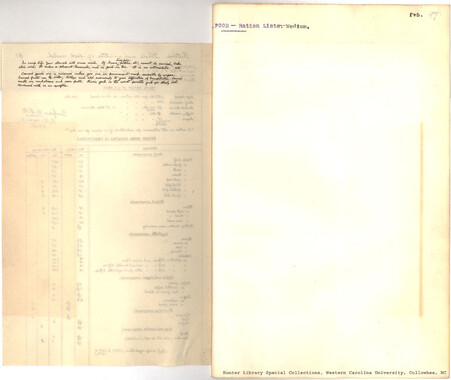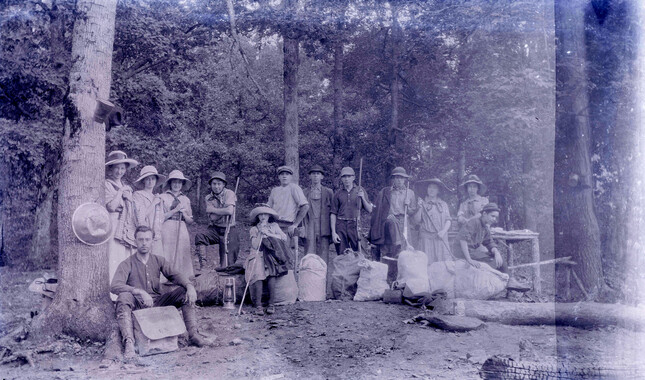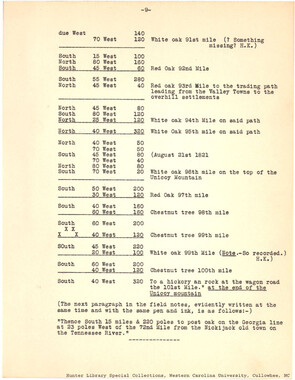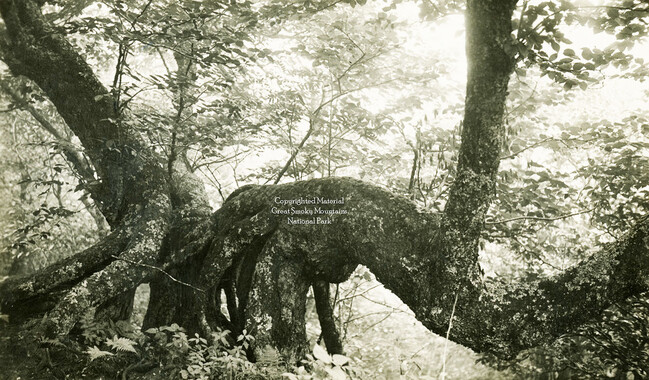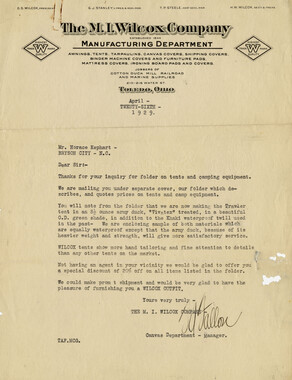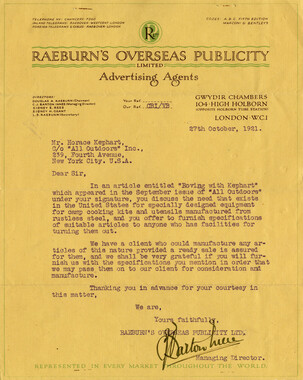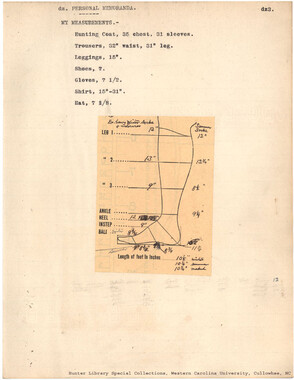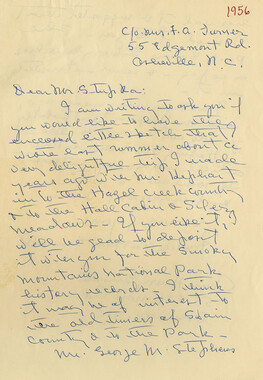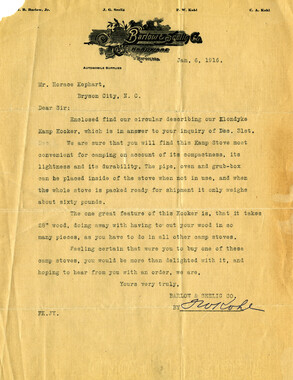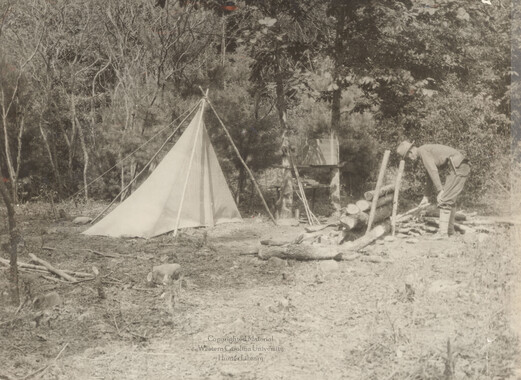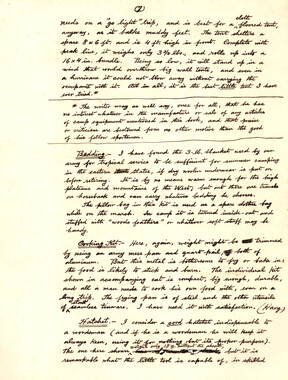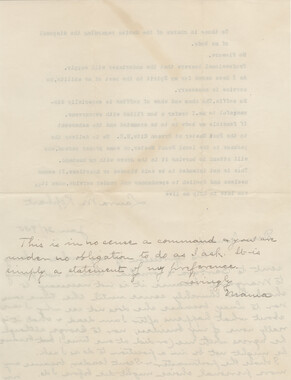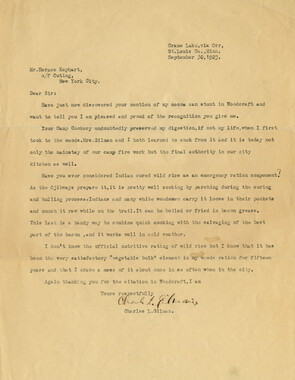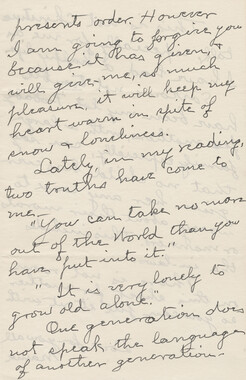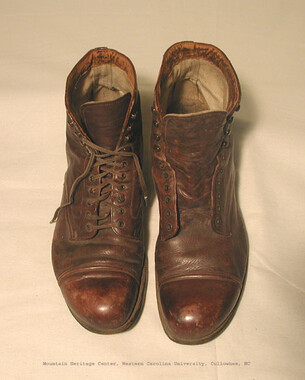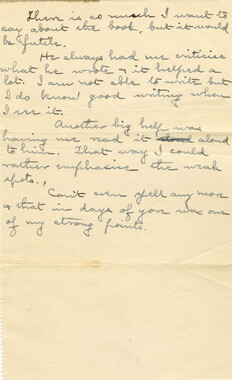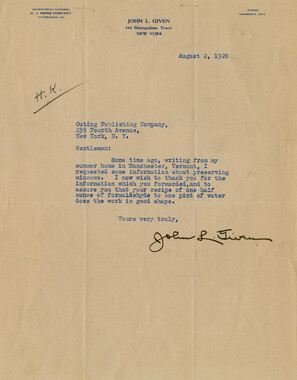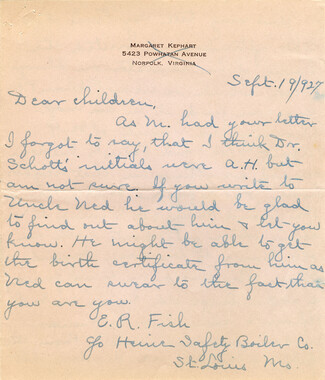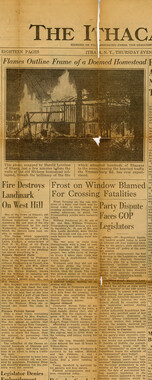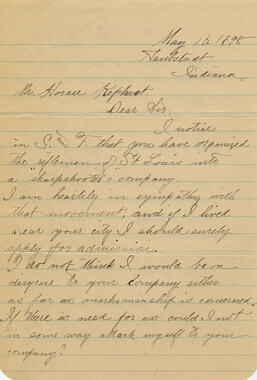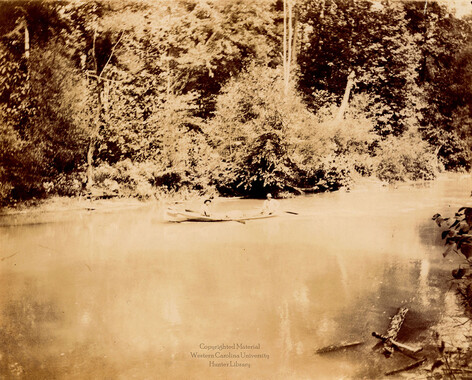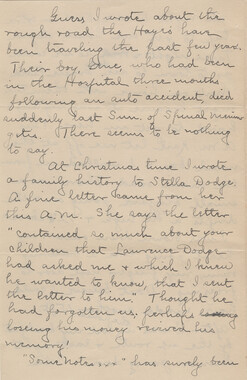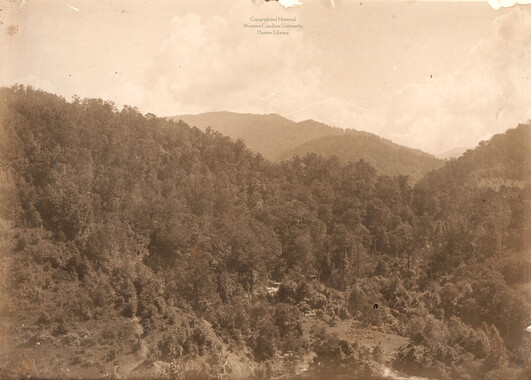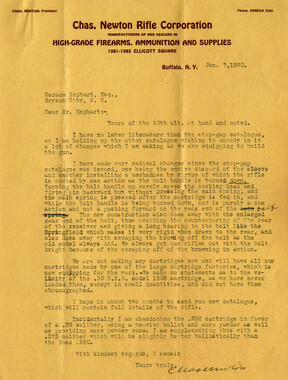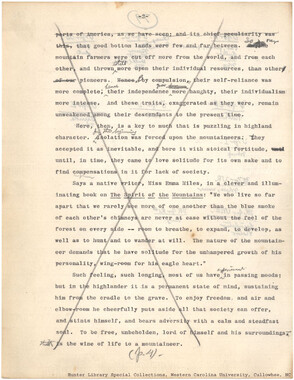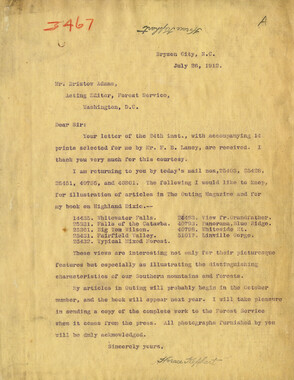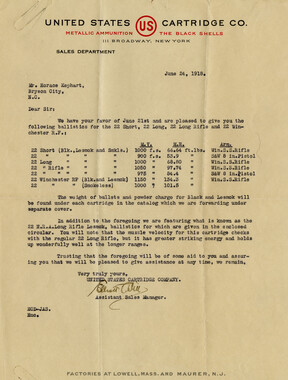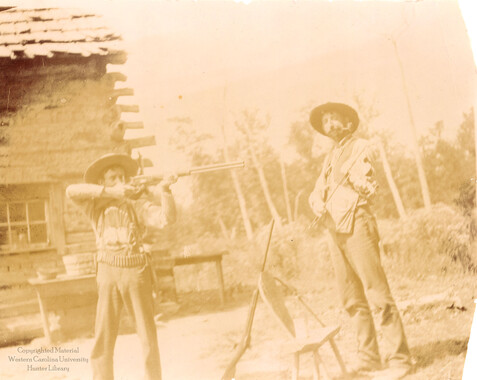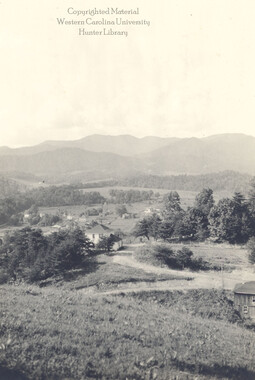Western Carolina University (20)
View all
- Canton Champion Fibre Company (2308)
- Cherokee Traditions (293)
- Civil War in Southern Appalachia (165)
- Craft Revival (1942)
- Great Smoky Mountains - A Park for America (2767)
- Highlights from Western Carolina University (430)
- Horace Kephart (941)
- Journeys Through Jackson (154)
- LGBTQIA+ Archive of Jackson County (24)
- Oral Histories of Western North Carolina (314)
- Picturing Appalachia (6772)
- Stories of Mountain Folk (413)
- Travel Western North Carolina (160)
- Western Carolina University Fine Art Museum Vitreograph Collection (129)
- Western Carolina University Herbarium (92)
- Western Carolina University: Making Memories (708)
- Western Carolina University Publications (2283)
- Western Carolina University Restricted Electronic Theses and Dissertations (146)
- Western North Carolina Regional Maps (71)
- World War II in Southern Appalachia (131)
University of North Carolina Asheville (6)
View all
- Allanstand Cottage Industries (62)
- Appalachian National Park Association (53)
- Bennett, Kelly, 1890-1974 (1388)
- Berry, Walter (76)
- Brasstown Carvers (40)
- Carver, George Washington, 1864?-1943 (26)
- Cathey, Joseph, 1803-1874 (1)
- Champion Fibre Company (233)
- Champion Paper and Fibre Company (297)
- Cherokee Indian Fair Association (16)
- Cherokee Language Program (22)
- Crowe, Amanda (40)
- Edmonston, Thomas Benton, 1842-1907 (7)
- Ensley, A. L. (Abraham Lincoln), 1865-1948 (275)
- Fromer, Irving Rhodes, 1913-1994 (70)
- George Butz (BFS 1907) (46)
- Goodrich, Frances Louisa (120)
- Grant, George Alexander, 1891-1964 (96)
- Heard, Marian Gladys (60)
- Kephart, Calvin, 1883-1969 (15)
- Kephart, Horace, 1862-1931 (313)
- Kephart, Laura, 1862-1954 (39)
- Laney, Gideon Thomas, 1889-1976 (439)
- Masa, George, 1881-1933 (61)
- McElhinney, William Julian, 1896-1953 (44)
- Niggli, Josephina, 1910-1983 (10)
- North Carolina Park Commission (105)
- Osborne, Kezia Stradley (9)
- Owens, Samuel Robert, 1918-1995 (11)
- Penland Weavers and Potters (36)
- Roberts, Vivienne (15)
- Roth, Albert, 1890-1974 (142)
- Schenck, Carl Alwin, 1868-1955 (1)
- Sherrill's Photography Studio (2565)
- Southern Highland Handicraft Guild (127)
- Southern Highlanders, Inc. (71)
- Stalcup, Jesse Bryson (46)
- Stearns, I. K. (213)
- Thompson, James Edward, 1880-1976 (226)
- United States. Indian Arts and Crafts Board (130)
- USFS (683)
- Vance, Zebulon Baird, 1830-1894 (1)
- Weaver, Zebulon, 1872-1948 (58)
- Western Carolina College (230)
- Western Carolina Teachers College (282)
- Western Carolina University (1794)
- Western Carolina University. Mountain Heritage Center (18)
- Whitman, Walt, 1819-1892 (10)
- Wilburn, Hiram Coleman, 1880-1967 (73)
- Williams, Isadora (3)
- Cain, Doreyl Ammons (0)
- Crittenden, Lorraine (0)
- Rhodes, Judy (0)
- Smith, Edward Clark (0)
- Appalachian Region, Southern (2393)
- Asheville (N.C.) (1886)
- Avery County (N.C.) (26)
- Blount County (Tenn.) (161)
- Buncombe County (N.C.) (1664)
- Cherokee County (N.C.) (283)
- Clay County (N.C.) (555)
- Graham County (N.C.) (233)
- Great Smoky Mountains National Park (N.C. and Tenn.) (478)
- Haywood County (N.C.) (3522)
- Henderson County (N.C.) (70)
- Jackson County (N.C.) (4692)
- Knox County (Tenn.) (25)
- Knoxville (Tenn.) (12)
- Lake Santeetlah (N.C.) (10)
- Macon County (N.C.) (420)
- Madison County (N.C.) (211)
- McDowell County (N.C.) (39)
- Mitchell County (N.C.) (132)
- Polk County (N.C.) (35)
- Qualla Boundary (981)
- Rutherford County (N.C.) (76)
- Swain County (N.C.) (2113)
- Transylvania County (N.C.) (247)
- Watauga County (N.C.) (12)
- Waynesville (N.C.) (68)
- Yancey County (N.C.) (72)
- Aerial Photographs (3)
- Aerial Views (60)
- Albums (books) (4)
- Articles (1)
- Artifacts (object Genre) (228)
- Biography (general Genre) (2)
- Cards (information Artifacts) (38)
- Clippings (information Artifacts) (191)
- Crafts (art Genres) (622)
- Depictions (visual Works) (21)
- Design Drawings (1)
- Drawings (visual Works) (184)
- Envelopes (73)
- Facsimiles (reproductions) (1)
- Fiction (general Genre) (4)
- Financial Records (12)
- Fliers (printed Matter) (67)
- Glass Plate Negatives (381)
- Guidebooks (2)
- Internegatives (10)
- Interviews (811)
- Land Surveys (102)
- Letters (correspondence) (1013)
- Manuscripts (documents) (619)
- Maps (documents) (159)
- Memorandums (25)
- Minutes (administrative Records) (59)
- Negatives (photographs) (5835)
- Newsletters (1285)
- Newspapers (2)
- Occupation Currency (1)
- Paintings (visual Works) (1)
- Pen And Ink Drawings (1)
- Periodicals (193)
- Personal Narratives (7)
- Photographs (12975)
- Plans (maps) (1)
- Poetry (5)
- Portraits (1663)
- Postcards (329)
- Programs (documents) (151)
- Publications (documents) (2237)
- Questionnaires (65)
- Scrapbooks (282)
- Sheet Music (1)
- Slides (photographs) (402)
- Sound Recordings (796)
- Specimens (92)
- Speeches (documents) (15)
- Tintypes (photographs) (8)
- Transcripts (322)
- Video Recordings (physical Artifacts) (23)
- Vitreographs (129)
- Text Messages (0)
- A.L. Ensley Collection (275)
- Appalachian Industrial School Records (7)
- Appalachian National Park Association Records (336)
- Axley-Meroney Collection (2)
- Bayard Wootten Photograph Collection (20)
- Bethel Rural Community Organization Collection (7)
- Blumer Collection (5)
- C.W. Slagle Collection (20)
- Canton Area Historical Museum (2110)
- Carlos C. Campbell Collection (282)
- Cataloochee History Project (65)
- Cherokee Studies Collection (4)
- Daisy Dame Photograph Album (5)
- Daniel Boone VI Collection (1)
- Doris Ulmann Photograph Collection (112)
- Elizabeth H. Lasley Collection (1)
- Elizabeth Woolworth Szold Fleharty Collection (4)
- Frank Fry Collection (95)
- George Masa Collection (173)
- Gideon Laney Collection (452)
- Hazel Scarborough Collection (2)
- Hiram C. Wilburn Papers (28)
- Historic Photographs Collection (236)
- Horace Kephart Collection (861)
- Humbard Collection (33)
- Hunter and Weaver Families Collection (1)
- I. D. Blumenthal Collection (4)
- Isadora Williams Collection (4)
- Jesse Bryson Stalcup Collection (47)
- Jim Thompson Collection (224)
- John B. Battle Collection (7)
- John C. Campbell Folk School Records (80)
- John Parris Collection (6)
- Judaculla Rock project (2)
- Kelly Bennett Collection (1407)
- Love Family Papers (11)
- Major Wiley Parris Civil War Letters (3)
- Map Collection (12)
- McFee-Misemer Civil War Letters (34)
- Mountain Heritage Center Collection (4)
- Norburn - Robertson - Thomson Families Collection (44)
- Pauline Hood Collection (7)
- Pre-Guild Collection (2)
- Qualla Arts and Crafts Mutual Collection (12)
- R.A. Romanes Collection (681)
- Rosser H. Taylor Collection (1)
- Samuel Robert Owens Collection (94)
- Sara Madison Collection (144)
- Sherrill Studio Photo Collection (2558)
- Smoky Mountains Hiking Club Collection (616)
- Stories of Mountain Folk - Radio Programs (374)
- The Reporter, Western Carolina University (510)
- Venoy and Elizabeth Reed Collection (16)
- WCU Gender and Sexuality Oral History Project (32)
- WCU Mountain Heritage Center Oral Histories (25)
- WCU Oral History Collection - Mountain People, Mountain Lives (71)
- WCU Students Newspapers Collection (1744)
- Western North Carolina Tomorrow Black Oral History Project (69)
- William Williams Stringfield Collection (2)
- Zebulon Weaver Collection (109)
- African Americans (390)
- Appalachian Trail (35)
- Artisans (521)
- Cherokee art (84)
- Cherokee artists -- North Carolina (10)
- Cherokee language (21)
- Cherokee pottery (101)
- Cherokee women (208)
- Church buildings (167)
- Civilian Conservation Corps (U.S.) (110)
- College student newspapers and periodicals (1830)
- Dams (103)
- Dance (1023)
- Education (222)
- Floods (61)
- Folk music (1015)
- Forced removal, 1813-1903 (2)
- Forest conservation (220)
- Forests and forestry (917)
- Gender nonconformity (4)
- Great Smoky Mountains National Park (N.C. and Tenn.) (154)
- Hunting (38)
- Landscape photography (10)
- Logging (103)
- Maps (84)
- Mines and mineral resources (8)
- North Carolina -- Maps (18)
- Paper industry (38)
- Postcards (255)
- Pottery (135)
- Railroad trains (71)
- Rural electrification -- North Carolina, Western (3)
- School integration -- Southern States (2)
- Segregation -- North Carolina, Western (5)
- Slavery (5)
- Sports (452)
- Storytelling (245)
- Waterfalls -- Great Smoky Mountains (N.C. and Tenn.) (66)
- Weaving -- Appalachian Region, Southern (280)
- Wood-carving -- Appalachian Region, Southern (328)
- World War, 1939-1945 (173)
Horace Kephart Journal 27
-
Horace Kephart (1862-1931) was a noted naturalist, woodsman, journalist, and author. In 1904, he left St. Louis and permanently moved to western North Carolina. Living and working in a cabin on Hazel Creek in Swain County, Kephart began to document life in the Great Smoky Mountains. He created 27 journals in which he made copious notes on a variety of topics. Journal 27 (previously known as Journal XVIII) includes information on North Carolina laws of 1777, a surveyors field book from 1821, and possibly notes for a novel. Click the link in the Related Materials field to view a table of contents for this journal.
-
-
' HORACE KEPHART BRYSON CITY, N C . 17 HORACE KEPHART BRYSON CITY, N C . L OF ORTH CAROLI A, 1777. Chapt r II. An Act for the Encouragement o! the Militia and Volunteers employed in prosecuting the present Indian War. I. Whereas the vigorous prosecution of the present Indian War may much sooner put an end to the same: In order therefore to encourage and stir up an enterprising spirit among the Militia and Volunteers employed in the said War. II. Be it Enacted by the General Assembly of the State of North Carolina, and by the authority of the same, that from and after the first day of June next, if peace shall not be made, a Premium of fifteen Pounds for each prisoner, and a premium of ten pounds for each scalp, shall be paid out of the Treasury to the Captor being in the service of the State, on producing a prisoner or scalp, and making oath that the prisoner was taken by him after the said first day of June, or that the scalp was taken and fleeced off the Head of an Indian Man slain by himself, after the said first day of June. III. And be it further enacted by the authority aforesaid, That a premium or reward of forty pounds for each scalp of an Indian Man, and a premium, or reward of Fifty Pounds, for producing an Indian Man Prisoner, be paid to any person in this State, not in the pay thereof who shall voluntarily undertake to make war upon the said Indians after the time aforesaid: Provided peace shall not before that time be made with the same Indians, and until peace shall be made, the Captors making oath as aforesaid, that such scalp or prisoner was taken by him after the said first day of June, and that the Indian so killed or taken was of the Nation of Indians commonly known by the name of the Cherokees; and that the scalp produced was actually taken from an Indian killed by the person claiming the same. (State Records of North Carolina. Vol. XXIV, page 15.-Laws of 1777-1788.) L ( t . 0 ' 1777-17 C t r I. otin y t Di 0 I , 1777. • . Vo . ) IV, .1 1.-- (NOTE:) Above is the earliest use of the name Great Iron ount in that I have found so f r {April 23, 1930). H.K. The earliest use of ''Great Iron or Smoky ountain", so far found, is in an act of 1789 by which orth C rol1na cedes to the United Stat s 'certain estern lanas," to it, the ~resent S~ te of Tennessee. (State Records of N.C. Vol. X V, p.4.J Prior to the Revolution, tpe mountains of estern North C rolina re referred to in public aocuments of • C. as the Ch rokee 1ountain ,nand they w re reputed to be "im abl " (See Coloni 1 Records of N. c. ole. IV, 254; V, 38 t II,876, 879; III, 656, 561, 563-564, 572; I, 220, 222, 227-228.) The following, and every part thereof, is a true, complete and exact copy of the book of field notes made by William Davenport, the Surveyor for the State of North Carolina, when the State line was run between North Carolina and Tennessee in the summer of the year 1821. The book of notes was found by Edmund Jones,Jr . , on the lOth day of November, 1910, in a secret drawer of an old sideboard, formerly belonging to William Davenport, at his old home in Caldwell County . Both the home and the old sideboard are at present the property of his grandson William Davenport Jones, who, together with Mrs. Emma H. Cilley, was present when the book of field notes was discovered. Edmund Jones, Jr . , is a great-grandson of William Davenport . The notes are contained in a book six and a half inches long by four inches wide and are written on unruled paper. The book is stitched together with coarse thread, with heavy brown paper backs, and is in a perfect state of preservation . On the outside front page is written:-- "W. Davenport's Field Book July 18th, 1821. " "July the 19th 1821 Begun at the Cattalucha track to run the line between the State of North Carolina & Tennessee Marked a rock there on North Carolina side N. C. 1821 and on the other side T.E.N 1821 - and rune with the line that J M Dowel M. Matthews & D. Vance run in the year 1799 and rune with said line about 2 miles and a half to where they stopped South 88 W 6 poles - No 42 W 12 Do South 64 W 14 Do South 50 Do 16 - Do Do 64 W 27 Do West 30 Do South 65 W 38 Do S 18 W 23 Poles s 30 W 60 Poles X N 60 W 60 P Hickory Chestnut Chestnut Do Pine Chs't B. Gum -2- X S 75 w 100 p X S 60 w 80 p X Wes--t -------- 80 -p ---C-h-estnut 2d M ------ X West 40 p X S 75 w 30 p X S 85 w 40 p X S 50 w 50 p X S 80 w 40 p X N 80 w 50 p X S 60 w 20 p X N 80 w 50 p Maple 3d M X N 80 W 60 P S 50 W 70 P to the top of the Smokey Mountains at a spring on the extreme height of the Mountain X S 50 W X S 30 W X South X S 20 E X S 30 W X S 15 W X S 70 W 20 p 80 p 90 P burch 40 p 100 p 120 p 60 P Red Oak ---------------- X S 80 W 70 P X S 30 W 100 P 4th M 5th M X S 25 W 80 P to red oak in a low gap lay by on sunday and monday and set out tuesday morning X South (30 W 70 Burch at 6 miles due So 80 " 35 W 60 " 70 W 180 Spruce pine at 7 miles X South 30 W 100 due West 100 X South 40 W 120 spruce pine at 8 miles X S 70 W 320 spruce pine at 9 miles s 80 w 228 X due South 40 X South 10 W 52 fir or balsam pine at 10 miles X n X n X n 10 w 40 p 65 " 80 p 60 w 60 p X n 35 W 140 P Fir or balsam pine at ll miles X " 30 East 154 P X due South 166 P Balsam pine at 12 miles at the top -3- 160 P of the main Smokey or Iron Mountain 80 P on a high Mt head of big (unintelligible) from the point to the (cannot be deciphered~ ::.:-===---=::..._:.:~~-....:8::..:0::....:...P Bush at 13 mi 1 e s 80 p 80 p 80 p 80 Spruce pine at 14 miles on a high point -----------------=of~S=m~okey Mts X due South X South 30 West X n 70 West X South X n X n X n 40 West 80 West 35 West 25 West X South 10 West X n 25 West X due South X South 20 West South X 30 West n 50 West X " 75 West due West X South 80 West X North 70 West X North 45 West X South 60 West due X West North X 70 West 160 low gap 80 80 Burch at 15 miles 80 80 80 80 to a Burch & Mt China tree at 16 miles in a low gap between East fork of Little Pigeon and Oconolufty River 80 60 40 140 Spruce pine at 17 miles 40 120 80 80 Fir or balsom at 18 miles 40 120 160 Spruce pine at 19 miles 40 220 60 Spruce pine at 20 miles at the top of an extreme high pinac1e in view of Severeville South X 50 West 260 " 70 W 60 Burch on high point at 21 miles South X 85 W 40 " X 30 W 180 _" _ ___:;:X....._=1=0-'E=a=s:..;t"---=1~0..;..0 Spruce pine at 22 mi 1 e s X South South n 25 West 15 East 50 West 30 West 70 w 94 20 60 60 86 to Porter's Gap{ from Porters Gap (30th July 1821) Spruce pine at 23d aile South South due South North South No North 30 w 80 80 w 40 80 w 40 60 w 160 20 w 80 60 w 180 60 65 West 60 35 West ~6 70 w 0 60 W/ 100 65 w 60 0 60 60 100 60 60 60 100 WesL 60 50 w 160 40 85 w 80 w I 80 60 180 5th of August 1821 South 20 West 160 -4- to the Indian Spring waters of Lufty Buroh 24th mile Spruce pine at 25th mile Spruce pine 25 mile, august the 1st 1821 wrong Balsom pine 26 mile wrong Balsom pine 27th mile Spruce pine 28th mile wrong Balsom pine 29th mile the above corner is against the head of the west fork of Pigeon River near an old Indian camp (aug the 2nd 1821) which is at a low gap at the head of Big Creek of Tennessee and if there ever is a wagon road through the Big Smokies Mountain it must go through this gap South 70 West 160 Spruce pine and Burch 26th mile South 55 est 100 40 est 160 ----------------~6~0 Balsom pine 27th mile (Aug 6th 1821) South 75 West 10 w 70 t 80 Wt 40 40 100 140 Beaoh 28th mile at the head of the --------------------~Iouth t fork Lufty South est 45 Wt 30 t 160 80 80 Beach 29th mile Indian path at the head --~----------------~of deep cr • -5- South 20 Wt 80 50 Wt 60 15 Wt 80 , -------=3~0_W~t~--~l~O~O~~Spruce pine 30th mile ~S~ou~t~h~~5~5~W~t--~3~2~0~~Wild Cherry tree 31st mile (aug 7th South 50 Wt 160 to Meiges (?) post 40 West 160 Balsom pine 32d mile had of Little ------------ River c South 25 West 320 Balsom Pine 33rd mile South South 100 120 75 West 40 west 80 West 100 Balsom pine Town ~· · West 120 South 75 West 100 =No~r~t~h~~7~0_W~e~s~t~~l~O~O Spruce pine 35th mile South 75 West 160 ___________W~ e~s~t __l ~6~0~~B~u~c~k~eye 36th mile, in rich b~ech flat Aug 8th 1821 South 80 West 80 60 West 120 =N~or~t~h~~7~5~W~e~s~t _ l=2~0~~M~ount China 37th Mile West 160 South 50 West 40 d=.u::.:e::._.:W~e~s~t:.__ _____ ...;l:.:2::.:0~-=B:.::e:::::a::.ch. 38th mile South 70 West 180 =N o~r~t~h~~S;.;::O;__;;W~e~s~t-=-14::.:0:::.-_..,:C:.::h=e ry tree 39th mile N~~o~rt~h~~6~0~W~e~s~t--~3~20~-C~herry tree 40th mile n 70 West 160 South 45 West 80 __"_ _ ____ :7~0~W~e~s~t ___8 ~0~~B~e~ach 41st mile South 70 West 80 lOth August 1821 due West 80 South 60 West 160 Beach 42nd mile North 65 West 100 South 45 West 160 d=u:e~W~e~s~t~--------~60~_..,:S~p~a~nish oak 43rd mile North 65 West Due West 80 240 Beach 44th mile South 80 West 320 Beach 45th mile head of the est fork of Little River. -6- South 55 West 40 South 60 West 260 Beach 46th mile North South North South II 55 West SO 50 West 140 80 West 120 Beach 47th mile 55 West 160 (August llth,l82l 70 West 160 Buck eye 48th mile Due West 320 Burch 49th mile, at head of Abrums Creek South 40 West 100 North 70 West 120 South 50 West 100 Red Oak 50th mile Jlr Due West 80 South 30 West 40 11 80 West 100 " 10 West 100 Cucumber tree 51st mile South 40 West 200 11 75 West SO 40 West SO Chestnut tree 52nd mile South 75 West 120 35 West 100 SO West 100 White oak 53rd mile South 35 West 200 (August 13th 1821 50 West 120 Red oak 54th mile at Equenutty path to ------------------~Cades Cove South 60 West 100 70 est 120 due West 100 Red oak 55th mile South SO West 320 Red oak 56th mile due West 320 To the top of the bald spot in sight of ___________________T ellessee Old Town 57th mile South 65 West 320 Red Oak 58th mile in the edge of the ------------------~second bald spot South 25 West 320 Red Oak 59th mile South 45 West 160 25 West 160 Hickory 60th mile in a low Gap at the ------------------~path from equinotty to Tellessee South 20 West SO 50 West 100 South 20 West 100 Red oak Slat mile South 20 West 60 -~ South 60 south 50 West 100 d~u~e~W~e~s~t----~~l~O~O~~Looust 62nd mile South 75 West 220 55 West 100 Red Oak 63rd mile South 30 West 40 45 West 80 15 West 80 ------~6~0_W==es~t~~l=2~0--=Large White oak 64th mile South 75 West 320 Crossing Tennessee River to a large White Pine So side of the River at the mouth of (August 15th) a large Creek 65th mile South 80 Up said creek 40 West 80 70 West 40 South 60 due West 60 Spruce pine 66th mile South 65 West 80 20 West 60 70 West 40 ------~2~0~W~e~st~~l~4~0~~Buroh 67th mile at Cheogee path due West 140 (August 16th 1821 South 15 West 160 Sycamore 68th mile South 30 West due West 180 20 South 35 West 120 Maple on the East side of said Creek ------------------~69.th mile South 30 West 320 Burch on the West bank of said Creek ------------------~70th mile South 40 10 West 60 August 17th 1821 due West 60 ~So~u~t~h~~3~0-=W~es~t~~2~0~0~~Pine 7lst mile South 35 West 80 80 West 160 30 West• 80 White oak 72 Mile om a ridge between the aforesaid Creek and Citico Creek •Note.-- Park Survey has here noted correction, so as to read ---- 30 East. instead of 30 West. (H. K. ) South 30 East 200 60 East 120 Red oak 73rd mile South 100 45 East 100 10 West 120 Maple 74th mile -8- South 25 East 160 10 East 160 Beach 75th Mile Main Mountain South 25 West 320 Spanish oak 76th Mile in a low Gap South 25 West 100 August 18th 1821 South 60 55 West 160 Red oak 77th mile South 20 West 40 70 West 80 South 40 45 East 160 Maple 78th mile South 15 West 100 70 East 100 30 East 120 Beach 79th mile South 20 West 260 10 East 60 Beach 80th mile South 100 60 East 220 Red Oak 8lst mile South 15 East 200 25 West 80 40 West 40 Beaoh 82nd Mile South 40 West 40 50 West 160 40 West 120 Red Oak 83rd mile South 40 West 320 Locust 84th Mile South 40 West 120 (August 19th1 1821 60 West 200 Chestnut oak 85th Mile South 60 West 320 Holly tree 86th mile near the head of the Middle Fork of Tellico River South 20 West 80 65 West 240 Red oak 87th mile South 80 West 320 Ed Oak 88th mile South 80 West 100 North 80 West 60 (August 20th 1821 South 50 West 120 10 West 40 Hickory 89th mile at the head of Beaverdam Creek South 10 West 100 due West 100 North 60 West 120 White oak 90th mile .. -9- due West 140 70 West 120 White oak 9lst mile (? Something missing? H.K.) South 15 West 100 North 80 West 160 ~So~u~t~h~--~4:5~W:e~st~----~6~0 Red Oak 92nd Mile South 55 West 280 North 45 West 40 Red oak 93rd Mile to the trading path leading from the Valley Towns to the overbill settlements North 45 West 80 South 80 West 120 N;.;.o=..:r=-t:::.::h=------=2:5_..:..:.W.:::.e~st~-----::1:..:2::..=.0 White oak 94th Mile on said path N~o=r=-t=h~--~4=0~W=e=s~t ___ ~3=2~0 White Oak 95th mile on said path North South North South South 40 West 70 West 45 West 70 West 80 West 70 West 50 50 80 (August 21st 1821 40 80 20 White oak 96th mile on the top of the Unicoy Mountain 50 West 200 -------=3;...;::0;._.:..;W=e=s-"-t __ ...;:l;:..;2;..;..0 Red Oak 97th mile South 40 West 160 ------~6~0_..:..:.W.:::.e~s~t ___ ~l~6::..=.0 Chestnut tree 98th mile South 60 West 200 X X :;;;;.X_--=X=---~4~0_..:..:.W=e=s~t --~1:..:2:.:-0 Chestnut tree 99th mile SOuth 45 West 220 -------~2;...;::0~W=e=st~---=l~O~O White oak 99th Mile (Note.-So recorded.) H.K.) South 60 West 200 --------=4;...;::0;._.:..;W=e=s~t ___ ...;:l=2~0 Chestnut tree lOOth mile South 40 West 320 To a hickory an rock at the wagon road the lOlst Mile ." at the end of the Unicoy mountain (The next paragraph in the field notes, evidently written at the same time and with the same pen and ink, is as follows:-) "Thence South 15 miles & 220 poles to post oak on the Georgia line at 23 poles West of the 72nd ile from the Nickijack old town on the Tennessee River." -lo- This appears to have been the end of the original field notee 1 but in a different ink the field notes which follow are given, all in Colonel Davenport's handwriting. After the word Mile after the lOlst the field notes go on as follows: . "at the end of the Uniooy mountain and runs South 320 poles to a White oak tree 102 miles (August 22 182111 South 320 poles - to a pine 103 mile Xing Branch South 252 poles to a Spruce pine on the bank of Higbawaesee River below the mouth of Cane Creek and rune up the bed of said River upwards of a mile to a Maple on the South aide marked IXDRA then the same course South 53 poles to a holly the 105 m (Aug 23rd South 320 P Spanish oak 106th mile, South 320 poles to Post oak 107 Mile South 320 poles to a Spanish oak 108th Mile South 320 poles Post oak 109 Mile South 320 poles crossing a creek to a white oak llOth mile South 320 poles to a black oak lllth Mile South 320 poles to a Red oak 112th mile crossing a mountain August 24 South 320 poles to an oak 113th mile South 320 poles to a white oak 114th Mile South 320 poles to a Black Gum 115th Mile South 320 poles to a post oak 116th Mile South 220 poles to a post on the Georgia line 23 poles est of the 72 mile on said line. 11- In the back of the book of field notes are the following entries:- "Co Mebane paid at Hill's for General Stokes 87t forage and turnpike 25 at upper turnpike 50 at Asheville 75 at Davdson 37t" on mext page: "Col Mebane paid W.D. expense from Knoxville Paid at Hill's Paid at Nelson's forage &o at upper turnpike at Asheville at Davidson's home 87i 75 cents 25 50 75 --~-t-- 3.50 " On the lower side of the page the following: "37i cents paid at Forbays bt Gen'l Stokes for me Liet Col Meben $4." On the outside of the last page of the cover is the following:- "Severe County election 18 (other two figures indistinct) for Govr Carroll 492 Ward 38 For Congress Cocke 477 For Senate Gillespie 264 Lowery 241 Representative 498" 19 7. K&tloot tr&o 1 300 aorea (nearly t q ) • METHOD • ., Brevity of descrition . Don ' t let a love of accuracy of detail produce pages that would be only a weariness to the reader . Brilliancy of narrative . The apt word; not the unusual . Ready 'invention of situations and events . Don't go too far in depicting unpleasant phases of life. Don 1 t preach. Yet be a realist by not deviating from the truth . Touch it up, idealize it, put it in bold relief; but let it be the truth . The diamOnd is as real as a lump of coal . Uncommon scenes, rare moments, characters transfigured by passion or emotion. Art dreads the commonplace . Most readers live drab lives . Give them color, stir their emotions, let them realize, for the time, their dreams and longings . What they like is the unknown~ and what they know can never occur to them . This delight is the oldest and most natural pleasure art can give . Atmosphere . Weather . Mountains . Streams . Woods . Animals . CHAPTER REVIEW . Natives and Wayfarers . Mt . Home Life . Dialect and Sayings . Woodcraft . Screen Situations . Scene . Character . Action . Character . Contrast . Grouping . Clash. Humor . Bupply and Alphabet . 1Poleon and Youlus • . Peter Ponder and "Poor Me . " Adam and Maple . Suspense . Mystery . ~- ~et..,.•. ..,.__ ~- OPE ING . On John's first trip from Conway's h follows the creek (forest, fords) and visits th old Ide place, finding it in ruins . Kit T rhune, ho has been fishing the bend, spies him crying there , but John does not know it . Kit joins Marian, who has been botanizing, and tells her of it . Sh says:"Don ' t tell." John camps in the bend above Ide place . Explores Nick ' s Nest , leaving his pack in the laurel so he can bore through the thickets . Prospects along branch, finding traces of rare minerals . Circumnavigat s the surrounding ridges . Describe them and the Pullback trail. He is careful to leave no "sign. " Sets out to explore sides of ridges . · Discovers the Fault (Tarr, index); also the bench hidden by hemlocks and the sinking spring .r Her .he levels a tent sit and ditches it . Cuts a trailway along side of ridge, where stragglers would b unapt to go, and leaves it "blind" at both ends . (Woodcraft, 232-235; 4to gcl-11 . ) He returns to Conway's and packs his outfit in four trips to Nick ' s nest, over Pullback trail . Mari~n gets the story of J P~ofeasor I e from Conway . JOHN AND RUTH-- Their Meeting in the Woods. She takes him by surprise at his third shifted oamp.-" Weloome, Maid Rosalind. This is the forest of Arden. 11 "'!thank ye, and be blest for your good comfort.' But r have no ourtle-axe upon my thigh nor bo r-spear in my hand." "The times have changed. I see a serviceable pistol at your waist." "Yes, 'a swashing and a martial outside.' The woods are good for target practice." ,. ---- ,_.A. She sings from the ballad of Robin Hood.- LWBL.,3:1312. l. ISUNDERSTANDING. Alphabet Thorne spies John panning the branch above Nick's Nest. Ruth, knowing something of atlook's spite, believes John is trespassing and robbing the owner of gold. THE DISCOVERY. John has been missing for weeks. Conway worried. Town gossip based on Matlock's known determination to get rid of John. Ruth consults Col.Sherwood. He sees the sheriff. Rumors start (The Virginian, 356). "Somebody said ... 11 Talk of organizing searching party (Harsell case); but nothing done. Ruth and Kit do some exploring of their own. Ruth gets lost in the fog. Nearly dead, she stumbles into Nick's Nest. John thunderstruck by her appearance. He tells "her his whole story. Emotion bursts all barriers. He declares his love. She quotes Markham's To the Thrush: "Lead on ..• 11 Fullwiler tries to assassinate John and is prevented only by a gnat flying into his eye and causing him to overshoot. John is on the lookout. Hears someone approaching his cubicle. Stands with gun ready and Marian appears. There stood Marian Wentworth, pale but smiling, her slender hands in air.-- "Don't shoot, Mr. Holdup-man; you may have my purse, but please leave me my frat pin." ISU DERSTA DING. That's rhat he as: a skulker! She poun ed the pillow and a ore . A skulker! She burst into tears and sobbed herself fi lly to sleep . "Would you do such a thing?" she asked Conway. "Well, now-- no, of course not-- I wouldn't take from a man's own land, nor from Company land, or from the State or the Government; but,right sensibly lookin' at it, this Bill Matlock--" "What difference does it make-- Bill, Tom or Harry?" she demanded, quoting: 'The ten commandments will not budge, And stealing will continue stealing.'" "What I meant to say," continued Mark in his slow, measured way, " as that I don't consider-- that is, I ain't right clar in my mind as to Bill Matlock raelly ownin' that property. It's true he holds title. The law would defend his claim, no doubt. But it's my opinion and jedgement that he jist as much as stole that land,his own self, from pore old Ph feasor Ide." Ruth stared, angry and righteously determined in her stand, but evidently waiting for an explanation. "I reckon you never heered about the Pe feasor," ventured ark. "No." " ell, I don't know the ins and outs of it; but if you want f the truth about the whole business, -YU!~:::ra fine th perfess r s n how scan'lous Bill t~ ~k tre~ e , you ask Colonel Sherwood, some day, to tell you the story. He kne Ide better than anybody else did, and he thought a power of him." CLIMAX. Matlock, creeping upon John to murder him, is bitten by a rattlesnake . His horrors. John cures him (Ditmars) . NICK'S NEST. August. RIDGE. Blind end of trail from my oamp.-- Top of ridge: red oak, hite oak, chestnut, 3 tall pines, sourwood. Small kalmia, buokberry, huckleberry, gooseberry, azalea, greenbrier. Follow top of ridge due west. Tedious trail cutting with knife and hatchet through huckleberry and laurel. No outlook on top. Hard to tell where ridge goes as there is a deep gap to west and foliage too dense to see what is beyond. Grade around to left under low pines where there is no undergrowth. Down into gap. Careful to avoid Pullback trail as · thereby would miss Nick's Nest. Thick laurel on this south side but less bushes. Pullback trail due S. from crossing, 3 minutes. Small knob ith many lo pines. Creek in sight ahead and Nick's Ridg on south. Wide vie across north ridge acrose Deep Creek valley. Fine view of mountains to northwest, north and northeast. Deep gap beyond this point to est. Call this Lookout Knob. South side of ridge: oaks, chestnut, sour~ood, red maple, poplar, dogwood, hickory. Undergrowth as before. From south side of top of Lookout Knob hear water ~-. -.~-due south in gulch. It is Nick's Branch. High knob of Nick's Ridge directly opposite Lookout Knob, due south and near, crowned with many pines. Descent steep but easy: 7 minutes, through laurel and small pines. Blazed big chestnut, also gum, N. & s., two spots each. GULCH. The stream cascades down, choked with rhododendron, leuoothoe and fallen trees. Steep walla . Hemlock, chestnut, maple, baas ood, hickory, dogwood, black birch, box-elder, cucumber, buckeye, yellow locust, sassafras, with hazel, moose ood. All trees grow straight and very tall wit~ slightly tapering trunks. Often 60ft. to nearest limbs. Profusion of shade-loving herbs. Cohosh, snakeroot, Solomon's seal, wild sarsaparilla, trilliums, orchids, wild pea-vine, moonseed, galax, Indian cucumber, wild spikenard, a few ginseng. Pure blue berries of the Clintonia . Wild grape. Great rooks upheaved and tumbled in cyclopean confusion. Below sheer walls or overhanging ledges are thousands of rooks split and thrown at all angles, their edges not rounded but sharp, affording innumerable dens for foxes, wildcats, skunks and snakes. Rooks granite or the like, weathered and coated with polyphori to a mottle of gray and brown. Many covered with moss and ferns. The interstices, foxy-smelling and very gruesome black holes. Think of sprained ankle and rattlesnakes. Course of stream and lower banks of gulch so dense with leucothoe that it is hard to force a way through. Tripe and enmeshes one at nearly every step. Often must cut a way. Lower end a practically impassible bog, laurel, leuoothoe and fallen trees. Only animals noticed, late morning and afternoon: pileated woodpecker (whicker-whicker-whicker) and thrushes. (Squirrels, higher up, cutting on dogwood berries.) NIClf 1S NEST. See Rumbling Bald. HD,2?. The chaos of broken rooks is present also on the north side of this ridge, indicating that the rupture extends clear through the mountain, but only for 50-75 ft. in vertical plane, above this being solid. Presumably a faulted structure has sometime slipped, splitting and shattering the rock, but leaving the upper strata undisturbed. The surface debris visible on the north side of ridge is in no suoh profusion as on the south side. The innumerable nooks ..• Hamerton,l35. Roquefort oaves. Pierce's Epicure, May 125, 5. Grim blocks of shattered rook. Gloom. Late dawn and early sunsets. Gloom and inaction of rainy days. Long, lonesome nights. Damp night air. Fog. Wet bushes. Dew till 9 a.m. Insect pests. Snakes. Lizards. Wildcat and pheasant. Bears roaming for food, owing to scattering mast. (Chestnuts, late September.) NICK'S NEST. The Cubicle. John discovers a naturally concealed "bench" on the steep, thicketed south side of the north ridge. It is fortressed in front by a chaos of tumbled rooks and screened by the tops of tall hemlocks. Difficult and dangerous to climb up to and impossible of approach without making a noise. It is backed by an overhanging cliff. A spring flows from the cliff but its water sinks in the rock crevices, flows underground, and so reaches Nick 1 s Branch without surface sign. tJ ) 1-) John provides access by an "Indian ladder" which he hides in the laurel when away from camp. So keeps clear of making a trail or leaving scent for dogs. He builds a snug camp, about 10xl2 ft., partly of rooks, partly of poles, and roofs it with canvas camouflaged with paint. Wire screen-cloth encloses cupboard, meat safe, etc. Use of wood for fuel would make noise of chopping, tell- tale smoke by day and firelight by night, and would leave "sign" of stumps and chips. Avoids this by packing to camp his gasoline stove and gas from his oar at Conway's. Advantages over a tent. N.2o. Cluny's Cage. HD.l80. Kidnapped, 223. Enc. Brit.,V.,941. ( CAMPING. Summer. Food Essentials.-- Bread (keeps 4 days), flour, baking powder, potatoes, onions, bacon, ham, butter, Crisco, eggsJ or powdered egg, canned or powdered milk, lemon juice, tea, coffee, sugar, salt, pepper. Creamery butter kept at branch in ventilated tin lasts a week; canned butter indefinitely. Eggs scarce in town and country at this season-- hens moulting-- and it is seldom one can get any but storage or doubtful ones. Fresh meat spoils in half a day, in transit. Good things to add: canned fruit, jams, chili sauce, canned baked beans, brown bread, pumpernickel, beaten biscuit, canned soups for "stock," canned chicken, sausage, fish. Menu should be worked out in advance, as one is tired and dull at cooking time. A compartment box for utensils and one for food required daily should be built at home, to serve as cupboards in camp. Do not crowd them in packing, but put in only such articles as will fit in their proper places when the cupboard is in use. These two cubbies save lots of time and bother.• Hang butter can above branch lest it be carried away by flood. Usually much time is spent in getting straight poles for tent, etc., making table, bench, cupboard, and getting dry wood. Tent should be trenched as soon as set up. Tarpaulin ropes should have slides. Dining table needs rack for towels, paper towels, steel wool, soap, matches, lantern. Small table in tent for flashlight, watch, cigarettes, pistol, hat, contents of pockets. Pegs for hanging camp slippers and socks. Clothes rack for duds removed before retiring. Holdall for toilet articles and spare underwear. Soiled clothes bag. Tent ropes should be waterproofed. Bobbinet door by all means. Drawbacks.- Night fogs, morning dew, rainy days, muddy branchwater. Gnat in eye. Briars in fingers, or slivers. Blister (third finger of right hand) from chopping. Flies, hornets, yellow-jackets, ants, spiders, daddy-longlegs, snakes, lizards, skunks, mice, flying-squirrels. Katydids. *"That 1a my hunky-dory box," said be. Dark of the moon: Starlight . Cloudy nights . P..ain. Wind . Flooded bra.noh. Falling trees . CAMPING ALONE . Night . Foxfire from uprooted dead sumac . Glow-worms . Fireflies . Crickets, kat ydids, tree-toads . Camp-fire . C. & . Nature , 2n . • ( ' , -I 1 Jli, 1"1 I 1 • 1 , vH. ' /;). C;t.w ~ ~ ~ ,r.;] .,.:, . G ,,,x- ,.~ ~ CAMPING. Food and Cookery. /1 ..qJ ari was excited with housewifely interest in John's backwoods m~nage. She ran her eyes eagerly over the neatly arranged shelves of canned foods, which with their many-colored labels, looked like a miniature window-display of fancy groceries. "Where in the world did you get these things?" she exclaimed. "Not in a small town. Most of these labels are strange to me. And I never in my life saw fruits and vegetables put up in such cute little canal" "It took some search to find them. You see, I couldn't use more than a third of a large can1 $he rest would spoil, unless I ate the same stuff three meals straight, and then I'd be sick of the sight of it." "Whew-wt What is this . What is this?" cried Marian. "Boned chicken from Massachusetts, soups from Chicago and New Jersey, chili from Texas, Italian sausages, French filets of herring and tunny, Swiss cheese from the Emruenthal, brown bread from Boston, beaten biscuits from Maryland, pumpernickel from Germany, fruits a·nd nut butters from California, jams and jellies from York State, sauces from England, and-- as I live and breathe, puree de foie gras!" She slumped down in John's camp chair, struck her lap with both hands, and bowed her head as if beaten and exhausted. 11 I 1ve fancied you away back here,alone in the wilderness, living the simple life, roughing it like Daniel Boone , o e l t . And here I find-- oh~ hot ho~-I find you steeped in luxury, a sybarite, a gourmand, living to eat!'' 0 Mr. Cabarrus, what a fraud! 11 Her low laughter ·~~~~"Q.~o.• purled· like a brook flowing over mossy rocks. John flushed to the roots of his hair. He was shamed as if caught in a subterfuge. And at that his temper rose till he bit his lips. "You see, 11 said he, "my way of living here is something different from ordinary camping. I'm not here for. fun. I work hard in the woods all day. To keep that up, I must have good food and sound sleep o' nights. Good food doesn't mean just anything that will stick to the ribs. It means plenty of nourishment that tastes good. Whatever palls on the appetite is bad food, I don't care how many calories it would supply. Hog and hominy and vegetables swimming in grease have sent millions to the hell." "That's true, 11 agreed Marian. "Dyspepsia, scurvy, pellagra: they are the devil's tools." "Well, an old sourdough, on such a job as mine, might get along with half the weight of grub I've packed in here on my back. He'd be satisfied with the same old iron ration, meal after meal. But I wouldn't last on it. I'd get puny, if not down sick. So it's just plain common sense for me to smooth it as much as I can. Anyway, roughing it is a delusion of the tenderfoot or an excuse for playing the tramp." "Go on. I'm learning something:'·ws.aa.~~~ "Oh, I don't pose as an expert in such things; but I've had some experience in hard living and I know what it comes to. Now, I'm here on serious business. I've little time to potter -2- arou camp. I can't afford to do any slo coo ing: so it pays in the long run to buy this expensive stuff an~ pac it in here, heavy s it is. 11 "I see that." 11Then there's another reason for stocking up ith canned goo s instead of trying to go light. This cli~at is damp; the forest exhales moisture; there's a fo in the glens nearly every night an~ a heavy de stays on the bushes till nine o' clock in the morning. Food soon spoils 1n such atmosphere unless packed in tina, glass or the like." "Fresh meat would spoil here in a fe hours," observed arian. 11 ~hat do you use as substitute? Game and fish?" "Game is out of season, though I admit shooting a pheasant or two and some young rabbits-- the en seemed to justify the crime. Trout are fine; but one can't eat them every day. Fresh eggs and milk are out of the question; but I have them in powdered form and use a lot. Cheese and those California nut butters take the place of meat at times, and about t ice a week I v 1 h canned chicken and dumplings or canned fish made into various quick and tasty dishes. That foie gras you laughed at, and the mayonnaise you didn't detect, exalt the midday sand ich to something worshipful." "You don 1 t do much baking?' 11 0h, yea. heat flapjacks of my own mixing, buckwheats that are the real thing, biscuits, corn dodgers, even breakfast rolls and English muffins, are quick and ~aay to mak • t when I'm too busy or lazy to bake for my elf>! open a can of bro n bread or of pumpernickel or a package of those beaten biscuit. ~ I have plenty of good butter1 packed in enamel-lined tins, ~ t keeps sweet for months. Ample sugar/ jellies and jams sweeten my fare, lime juice corrects it, and once a week I defy the high priests of diet and revel in mince pie. hisper a secret: my canned mincemeat has brandy in it!" "Glorious!" " y I ask you to dine with me at five? I'll go back with you to Conway's and e'll get there before dark." "I'd love to; but not today. I must be getting back to (Jim Bum's) soon or Kit and the rest of them ill be out hunting me, thinking I'm lost." "Sorry; but now you have found the ay: please come again. Yo~ can't know how pleasant this little visit has been for me. I'd been a little- forlorn." CLAM-SHELL HOE NEW CLUE TO MERICA'S CAVE MEN l·&nl! , beC"· u a1 )Jel'lshahl nat<~re f• untl I fi \ uf \J.c l lh(6d ta\ ,. pllo:1 or th·>s~ dlsD>I erul In h t ~,l\ c t n 1 ntot• •. 1- hth(trl ,., 'tll'h r.tui :~ I,\ df'~a Jug ubjed !l3 t xtiit' · ha.~k l· and wood\ 01 h h&.\ r• not h~"en fvund t.. ·t t or the arJ
inslgnlfklllll, i. 1> t< look> pl fot• •·o tnparu.tho v.ork. h•'' t\1~~t, tl~ tJI }.;no" n ~·h n a ''~'tnPh tn pic ~ ma' be tnuud ih"l ' ill ' lh• fl• t fra&"menl :\!oM nr the • 611Peli\•ll Is ~lvn •i In I h~e 1l1L•111 o( tho nllt8 llll1 until t!XHnllll tHJH lt•tS hl:t\~11 Cflll\lll\!l''"· \ti\Uil l three object• on Ylew an ' fo>lltu, ,.,..., tl•• ho and tbe two hatchete. 'fl>e ha.tH.II nf this hue, eo rar unique. Is oC wood, , ... ,,n I anU uhout ciJrhteen inches lun~. 'l,on \rll thtl l>la en 'll·hen th~; original In !ian owner l•st laid 1t down. :,1peclal int<.:rcst atta~hcs lo lit" '0 'N 'A~IO NOSA~B .U:f'VHd3}f 30'1f~OH PROSPECTING. "All the rare ores are much heavier than or inary rocks, and for that reason remain in the pan aft r the lighter particles of quartz, granite and slate have passed out of the wash dish." ( cLeod,ll?.) "Terraces left by the stream before it out the ground down to its present level should be examine • 11 (MoLeod,4.) "The gravelly banks and bars of the stream are simply samples of the material of which the whole drainage zone is composed." (MoLeod,lO?.) Hence the stream draining the gulch ie panned first; then the terraces, etc., are examined if a find was made in the stream. • BERflliUM MAY OU~T IRON A~E~ New Metal Is Lighter Than Aluminum But Costly ,.~ .1..7. By 0. D. TOLISC (Unh·er.;oal Sen-Ice Corr!' pondent) B·ERT...JX, Aprll fl. - Tn th laboratories of Siemens and IIo.lske on of the biggest cl!>ctr!c concerns or Germany, Is now he!ng- manufactured what l~ ons!dcred the 1~ .e88 metal or the future. I R ThL· metnl IR hcryll!um. Sf\ Because of the ra11irl gro lh of r--'llltiil air trn nsporta!ion, metallurgic 1 · expert already for"E'e the end of 1 the iron age and the dominance ' of the lighter metals among which 1 beryllium promises a leading role. I Beryllium Is four times as J!ght as steel and one-third lighter than alummum. At the same tim~. it Is so hard that it cuts glas3. It is a goo_d conductor of electr!l'ity, passes • -rays better than aluminIum and makes excellent alloys with aluminum and magnesium. It melts only at 1.385 degreE"fil. while aluminum melts at 658 degrees. But heretofore. ben·ll!um 'l'l'aB merely a laboratory curiosity. It was discoYered In 1828 by the Ger- .' man ch~mlst Frederick -n·oehler who a year previous hnd discovered l'l!uminum. But all efforts to produce ber ·ll!um In commercial quantities fall d and up to re-c ntl;~· a gr.1m of this precious metal co t 50. • 'o"·· howeYer, Dr. Illig-, or Siemens and Halske, has p rf cterl 11. proce s according to which h~ produc d 120 ~trams a day In t"'o ex erimental electric stoves at ' cost of only 1.5 0. And he hopes to reduce the price shortly belo · that of silver to that beryllium ·1111 soon become a commercial pos i-blllty. Beryllium ore Is found exten!!lve. GETS GREAT GREEN BERYL. Field Museum Acquires Tranaparent Jewel of 4, 770 Carats. A piece or tran parent beryl Weighing 4,770 c rats, on of th~ largest specimen ot this precious etone ever obt lned, w s placed on exhibition recently In H. N. Hlg!n- 1 botham Hall or the Field Museum of Natural Hl~tory at Chicago. The stone, which ls or the quamll• rlne variety or beryl, wn brought from M dagascar by Dr. R:llph Lin· ton, Assistant Curator ot Oceanic anct Malay n Ethnology, who returned to Chicago after more than two years In that country as leader or the Captain Marshall Field Madagucar Expedition. To beryl were attributed manY magical powers by people In th-e ~ldFdle A.lt'es, according to Dr. Oliver · arrington, Curator of Geology l It was believed to give Its wearer 1n-: , sight, second sight and foresight, to Induce Bleep and compose the heart and mind. It was called the "sweettempered stone." It wu especiall u~ed In the seventeenth century fo~ dJVInatlon, by suspending and swln&'ing a beryl ring In a bowl fJiled with water. The edges of the bowl were marked with letters, and uutlons were answered by the be'hrJ•e stopping before certain letters. It was also I!Upposed to possees special power over evil spirits~ and It wu Bald that by holding a beryl In one'e mouth one "could summon a dl\11 from hell" and receive answera to questions. The new specimen at tne museUDt was found in the bed of a river by a prospector, !rom whom Dr. Llntou. obtamed lt. It has a rich greeu. color. It cut for jewelry It would make 250 average settings for rlnp and pins, after allowing for a los1 of about one-half ln cutting. -31- Cabarrus, encumbered by his ack, barely managed to hirl in time to meet this treacherous assault. There as but one thing he could do, and he did it quickly. Snatching off hie hat, he held it out to the dog. The beast seized it w th ious ~· Then Cabarrus kicked. The length of his arm plus hat was exactly the length of his leg. So the toe of his boot took the dog just under the ja , which snapped shut so suddenly as to make him bite his tongue. The.cur gave a yelp and ran off, bleeding at the mouth. Then the door of the house flew open. The woman appeared in full view, raging. She cursed Cabarrus with vile oaths and maledictions.-- "Ef my man was hyur he'd beat the hound out o• you fer that!" she cried. "Give him my compliments when he returns," said Cabarrus sweetly, "and tell him that vicious brutes are likely to get what is coming to them." He bo ed low, with a flourish of his hat, which made the woman speechless with rage; then he turned and went on. The virago rushed to her back yard and let out a long piercing cry, the alarm signal of the mountaineers. Then she began calling 11Youlus- Youlus! 11 "That 1 a their way of pronouncing Ulysses, 11 .murmttXed Caba.rrus. 11 She 1s calling her man from the fiel . How such people ever pick up classical names, heaven only knows; but they do." He broke into a hearty chuckle. PROSPECT I G. RARE MINERALS • See . lit. .L I " ( ~Iiley . ) 4.? ... 1o6. I>AiilDAI.I!S, OR. SCJB:N ANU THJI: Jo'UTUUI!:. fly J. B. S. Haldane 12mo Ne.. York : Jo~. 1'. Vutton A Oo. • ••· A IICientlst'a apeculaU-. u to tht future, revlewP.IO the fore as a material pos~cs•ing much greater opacity and at the same time being suitable for this use. orne of the large pottery manufacturers have found that the new material effects con· siderable economies in operation while pro· clueing a ware of equal or uperior quality. Zirconium oxide has alRo been used to some extent as a refractory for very high temper· ature work. It is interesting to note that the larger production of titanium oxide for use as a pigment to replace white lead in the new nitrocellulose lacquers has contributed to the production of zirconium oxid in quan· tity and at a price to make it favorably competitive with tin. Thus at a singl e stroke is acrompli•lwd thr c-onservation of two im· portant common metal ,, lend and tin, and two others, ordinurily rnnsidcrcd rur{e ar put usefully to work in industry. r.-4~ ~e.. - r,.. 1(- -- - ~- : J; .!Z-1: $(,, Ita V alue Haa Decidedly lnereaaed, Saya Federal Bureau. , "ot many ~" '" o th 1-e w1'1· few \UH' tor tttanluna n1in ral an1i prntlut·ttr. • but slnt•f! JIIU() tho US!' or r ITO•Illln) II containing tltanlt•ut has d•·d Ill Oil I hllport Ill \I liP of I Ita 1111101 h~s b<>en In mnldng thr alloy f<'ITO·t!ta tllliJn. whkh js ••mplnyPd t'hiPJl> &E"' 1 df'oXidlzf•t• Of Iron and 8tf't.'l. P tin .. fo1· protrcllvc t·Oa tlng on iron nnd att•rl are mat!<' b) mlxln& to ta t.• P• r ,., , t IU!Phalt with rutltl' anrl thlm11ug with tuqlt•nttn~. Tttanhun (•onH1ouruh11 urrntso of valnr in the In demand fnr the df'termtnatlon of titanium In th" prf'.s<'nce of othe•· elements without long and tedious l lephorie rec lver, baa b en confirmed by an account of tho detail of th proceSI! ot tt· nsmuta.tlon or the wa\ es of light Into those of sound. 'rh!s haa bet'n antt!'lpnt d, It Is ropc, rtcd, hy Dr. Fot KNII':R n' !.BE, v.·ho h!UI invl'nte nt by me11.n or which blind persons ha\· hcl'n enabled to read orl'hnary print through the U5 , In connection with th telephone, of tbe metal selenium, which has a. Yarylng tlcctl'ic conductivity under th lnnu. ence of light. Most lmprl'sl'lve, however. is not the fact of the t rlln~formntlon h:Y the seeming magic or this m tal, but the fact that thP light of Capella, I'IO remote that rts light has had to journey forty yea.I'I!I to reach this planet, though traveling as far as elgbt times around the earth In a. second, can llctuallv he " he.ard " The rays of liJht >h.·.n Cen r·.tJ Fr;;m.E hst~ncd to a few nights ago hnv there fore been on the wa~ since 1 I. D1·. ER.'KS'I' Fox NJcHor.s, the physici,t "ho died at the science rneetrng In "'al' rn Colorado anrt In southeastern Utah there wt>re large deposita of an orP called cArnotite. These cover about a hundre found Is about Rlxty-fh·" mlle.e from a railroad and 80 Mountainous that In many places there 1!1 a rls<' or fall In the local trallB of 2,000 f~t In a mlle. Prior to the World War, !lay!! a bulletlon of the National City Bank telling of radium and Its aource, carnotite oree from tlleee depOBita were shipped abroad for French anti German production of radium on a small scale. The embarJrQee on ahlpptnc stopped this export completely, although It had al~ea.dy been f•lllnc ott. MGC!h Waete Matnlal. "In the European orcR with which !\ladam Curie ha.d worked," contlnuee the bank, "there was about a gram of radium In every five or slx tona. In the Colorado ores there Is only one cram of radium In every five or six hundred tons of ore, and to obtain each of the~e tlve or aix hundred tona It 111 freq•.Mntly neoe1111a.ry to handle one hundred tona of worthless materlala. The men that had worked with the European orea wen fe"·; they could be counted eaally. They were unwllllnl' to work In the wlldernesa of Colora.do. Fo the ntw conditions Mr. Flannery trained nelt m~n. "HeadQuarter!! waa establlahed at a point oefitral to the work u a whole. A concentration mill wae built at a point that -.tas convenient to the many ore cla.lms that he houcht and lea11ed. Burroa were used to carr)' the orea f from tt,e deposits in the mountalna to this mlll, and to carry back to the miners the water and other supplles, for all of which th~y were dependent upon the l'&neral 1 eadquarters. "Vhere thfl <)re appeared on th sut· aM and alone the rim roclu!, Ita exu·nctlon waa comparatively aHy, with small charcea of dynllmlte. "'hen. aa more frequ ntly tul.ppena, the cleposlt ar founcl und r a heavy overload o othf'r mat rial, recular mining tunn~ls are run and dynamite <'hargett u t>d to break tho roc:k and other mat,.rlal" so that It may be carried to the l!lurfnc . In tze the ore bodlf'll vary from pockets containInc a f w pounl"la to deposiUI ) l~ldlng ~l~n':t~!.:: 1,800 tons in very ext·ep- .. .All there are oft<·n no lnrliC'.atlons leadlnc to a dflp It of ore, prolllle<'tlng Ia company maintains Ita refining plnnt. At tho mill In 'olorado JLnd In th np ratione pcrtnln· In&" to It >oome lUX> m~>n 11re kept busy. t the Canonsburg plant ~00 men are necC1'RMry to cnrry thron,;h all thP. cle-talle< l>· one pnrt radium for every four hutldrP s of the compRny In Pittsburgh. As It n•aches the •aboratory thla material Is In the form of radium bartum chloride. By successive fractional cr)·etn llza.tlo.a of .ne radium chloride and, at a later etage of the bromide, most of the radium Is 'obtahteo'! b:t li. salt co?J.ta.lnl!l,f more than 95 per cent. of PUl·e radium bromide. By further chemical treatment the bromide Is converted Into the sulphate or the chloride, ancl in the Ulerapeutlc .use of radium these two salts !lnd the Ia r£c.!lt uee. "For the use by the medical profe&slon radium IB m<'asured and sold by the llra.m, l. e., a small thimbleful. The presrnt prtce of n. &"ram Is $1!!0,000. The gram Is dh1dcd Into 1,000 parts, each ot which Is called a mllliiJl'am. These ae)l for $120 each. The a.vera&'e physician , whn has radium has from. r.o to ~!\0 mllll&"rama. When ea.ch preparation h11• been mads up ln tho special form deale- ' nated by the ph~· sllcnn ,the purity of the radium and tho accuracy of detail uf the container are certified to by the read of the radium researrh laboratortu of Ule company. The preparation Ia then tranemltted to tho Bureau of Standards at Washlnr;ton for compart! On with the Government's duplicate of tlle International Radium Standard." FOUND IN TURKESTAN American Philanthropists Plan Distribution at Cost RRANGE FOR MEDICINAL USE Latut Deposit Called Lar&ett and Richest In the World. ADISP.ATCH from Petrorra.d re· portlnt that a. Ruaalo.n Go\'ernment xpectltlon had tound wha.t Ia belle '~>d to be the IO.r1est and rlcheet deposit of rf.dlum In U1e orld bas brourht forth th ann•Junoeel'lt tho.t tour we<h~ men of t 11ls <.;tty &re pla.nnln&' to ~ta.bllah •· dletrlbutlon ~tBtem for the tmltcd States ·hereuy l'lldlum wUI be put at the dl•posa.l of PhYIJlclane and hoaplta.le at cost price. The •nnouncement, which doe& not include the names ut the tour pbllantbrQplate, ha.a been made by Dr. c. Bverett Field, President of the Radium :Ruearch Corporation and Director of the lta.dlum rnstltute, a hospital special· l&ln&' In radlum-tb rapy, at 323 Riveraide Drive. The Turkestan di'PO!dt will be the eource of supply It arran .. emenb can be made, accordlnl' to Dr. l<'leld. The uae ot radlurn a" a curative &l'ent tor tho allOYiatton of pain, e~;peclally In the treatment ot cancer, haa been ITOWinc ateadll)·, but the limitation of the sup· ply haa hampered rapid developmente ef thl11 now branch or fiCience. Althouc-h radium waa discovered by Prote.~~~or nd Mme. Curle In 18118, only three year11 after the discovery of the X-ra)' by Roentgen, Ita use has not devclopod .so rapidly. This hae been attributed not only to the cost, which two ycal'll a~ro wae approximately a.t tho rate of $(10,0110,000 a pound, and Is now almost three-quarters ot that, but to the ecan::lty of depoalts. The process ot extraction and purlrtca.tlon Ia expensl ~ the coet In American mines $85,000 • ~am, more than the t-rice at whicll Bel•1um can sell her radium !rom the Conl'o-now the main eourc~n this elde of the Atlantic. The world's m&JI· ufactured supply li'U recently e.tlmated at elcht ouncea, of hich three and a llalt had been extracted in America., three ouncu belnl' retained here. Only J:ncl&nd hu a ~rreater quantity on hand. 'l'bere 11 not enourh for the treaunent ot one cancer case In twenty, accordlnc to :.Dr. Field, tliroucb to America at o.s n r oat po11lble, probably ~ to 0 a nlllllc-ram. Our own chemla woul t Bel~rlan ore In the Conro Is richer buylnr now, but Ia the •reatcst tor g than tile radlwn eourcea of tho Unite<! ~ centr . tt the nus lao ~;upply .., as on· Btatea, bu\ the Turkelltan ore Ia rlcllor trollnd by Alrlerl<'an11 the 11111ttr.t· , oul·l than the African, accordlrll' to revorta • 'b• 8 ttled on & bo.sls of frl udly r•·l an4 an&lyaie of aamploa, of which on~ tlons It other countries want• <1>rom;ae radl um enoUI'h to treat G per cent. ot the cae , will be. vut at the ulspou..l of Amorlcau In th,. smaller towna and rural dlstrld aclcnce on a non·proflt tmels at ha.lt tnu there ts no way for a J.>atlent to accure preeent comrncrdal vrtco. thl treatment. \V. D, \'an4e~rllp lnlf'reot~d. "Dr. IIOWII.rd .1{ lly or Johns llopklna It Is exvcctcd that "' ashlng ton Vanderlip, actmc !or tho New Yorkers, will eountl Ule ltu1111lan Government, on an apprua.chln~e VIsit to Europe. ·w hcLlllH Ruasia woultl sell tho outvut or crunt concession ia not known. .Mr. \'at'ulct·llp undertook to look Into tho 'I'url a• ned ,h ' UHl llu~slan Uovcrnmdnl alt cauy lluot aent oul tho party wmch nmtiP thu 1.n '· At lhO }.ltt'sont uua~ ,1\. . llJt 1'1' aM i.. ...t ululu rnh~l·· U..l' ahu !,. nc t.luwu Lit \.d.l41h! l1ll.) Cllil101. lll ·ot lhtl t..:OIUV\OUUOU lH lu 0~ lt. v .. u.u io1 Uh.t u ...... tJ<.tl•, U tan d"'P .sit ha SOUl<:' , II W j, I> tO k aomo u.rrangclrl nt to curo the product. It Is c ccptlon Uy rich. 14.\lt ) ear fr, Yand~r!lp cot a samplo of thl! Fertn ta p'ltchblendt", the richest ladh 111 prouUC" • lt rtan ~ to to l)<'r cent. pure uranium content. The American ore hu a. cont nt ot 11(1 or 2 ~r cent., nnd th t of the Con.-o from 2ri to 40 per cent.. tho best of U.e la.tter found In small pockets The America deposita are In close tormtt• ttun with l'rnnlte and sD.ndstone and other mlnerale. bul the Turkestan strata. appear to be wltl out onl.amlnatlon. "ThO". Ra•Uum lnstltutc mentioned ln the Petrocr d d1~pa.tc~ ha.s no conn c· tlon "·tth the Radlutn lnstltutll In •ew York, but it waa th" only te arch or· ~tanlaatlon ln Russia hlch could tell the Russian Government what to do with Its find. "Our plan would be to c t the radium In 1012 and 1913 trlcct to arran e n~Vtlonal distribution. 'l'h C:o\·ernm nt financed the National Radium Institute and It produced 11lx crams In ltll. l'rcs• 11ure from private tntereata ., • brou!!'ht to bt•ar ancl the approprlatl n n! $3:;u,. 000 ' year waa 'IVIthllrawn. "Tht: 1'\"0IIent plan for non• Ill ofit til a· trlbution -.us for the lodlng mcrctJry anrl lead. But thl.' radium that ~oes Into commercial URea Is definitely lost tQ me•lkal science. It never comes ba;k.' Other New York physicians w rc lntor• cd In tho Russian report ot a bi tlncl In Turkestan. "Thi discovery will probably reduce th cost of radium." Dr. lt'r de rick Mu.c• nab J ohnaon ot the l\I mortal Hospital said. "The new t.cld Ia prob hly more \aluahlo than tho e 1n the Unltto.od Sto.tcs or the Congo. "In the go five tone of ore 11'1~• as much radium a& 500 ton In the United States. The Belgian supply Ia milled tn the Congo. but the I st 11tag s or pUrlflcation are carrlecl on In Bel· g1um.'' P.ad um 11 a. metallic ch<•ml I el m nt C. INERAL OUTPUT. HOW N. C. STANDS I THE PRODUCTION OF MINERALS 'blllP. GEMS. AREST GEMS OF ALL THE WOI~LD 0 THE LAND OF SK.Y :z;; Production Not Yet Fully Developed; Measured by Demand GEM SURVEY IS MADE PUBLIC Asheville Jew e 1 er Completes I nteresting Study of eautiful St ones Mined Locally I ( there I any on :f H'tur In \hlch \VPst t'll c.tt'olin.t might jnstl~ tal' t>rldo fr rn t h st rnt\IJnlnt nr rt.tttn'al rcsnurc s, thl ·nuld ell be in conn• tion '' ltlt the h<',luty of her 11 ... 1 lve g •n1s. \Jthvu ·h in a sen th hca uty and w ·.tlth Is kntJ\ a loc.!lly and to f,IJ' !'t attl•r •d points, 1 hl em} lha ·is " tlc. erv< s>l'£: tmg subjP<' t. J'h;s hool·let i,; for· ft•ee distributi. Jn. and .t Hi untie p: tetl that the in ILia! l'dltlon wll l xpc r nee a r 1pd d ;trbuton as soon u.s the p ulJll'
